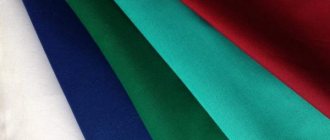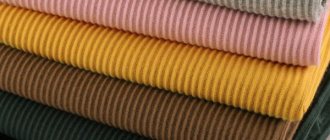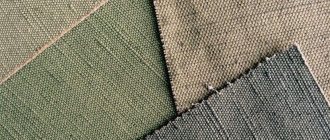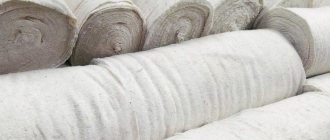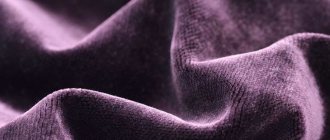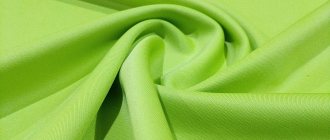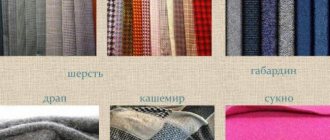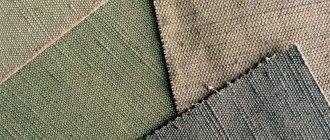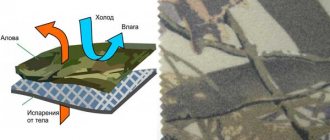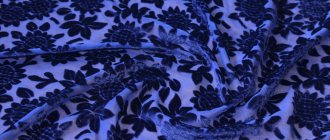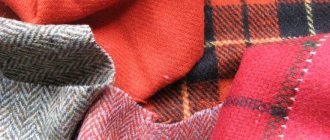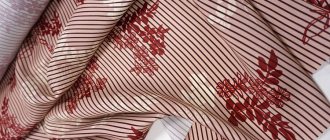Supplex matte
Supplex is a type of knitwear with a density of 70–170 g/m2. It differs from other elastic fabrics in its ability to stretch equally in all directions by approximately 300%. As a result, things sewn from this material do not deform and instantly return to their original size as soon as they are removed. It is not difficult to distinguish supplex from other knitwear even visually - the longitudinal and transverse rows of loops are not visible on the fabric, the texture is uniform thanks to a special technology of weaving threads.
Supplex: fabric composition
When considering supplex, the composition of the fabric is considered the primary point to which the closest attention should be paid. The structure of this material completely lacks longitudinal and transverse threads, since the production method is based on the spinning method. There are interlacing loops inside the fabric. The product contains several components, each of which gives the textile a certain characteristic or ability:
- Lycra (spandex or elastane). Synthetics, including polyurethane fibers that can stretch 6–10 times, hold their shape perfectly, are not susceptible to creasing, and are resistant to all kinds of stains.
- Nylon. Synthetic material that consists of polyamides. It is durable and has high water absorption.
- Microfiber. Microfiber made from polyester fibers, characterized by crease resistance, strength, and wear resistance. The big advantage of this component is that it does not shed or pill, and dries quickly.
- Lurex. It is a shiny thread with a metallic effect that is woven into other types of materials to give them shine and shine. Lurex is not widely used in independent products, since it has a high level of rigidity and low strength properties.
The composition of supplex may vary slightly at the discretion of the manufacturer.
Features and Specifications
Biflex is a material unique in its characteristics. A number of characteristic features of the fabric make it especially preferable to many others. Numerous users choose this particular canvas for the following reasons:
- The textile is pleasant to the touch, has good heat transfer, does not cause the slightest irritation, it can be worn directly on the naked body, while engaging in active sports without experiencing discomfort. The soft texture provides positive tactility.
- The peculiarity of supplex is that, although it is a synthetic product, it is non-toxic, hypoallergenic and does not have a negative impact on human well-being.
- Painting in any shades is allowed. There are more than 250 options in the color palette. You can apply spraying and hologram. The drawings are stable on the surface. Discoloration does not occur after washing and under the influence of ultraviolet rays.
- High material density. The fabric is characterized by significant wear resistance; due to its density from 70 to 290 g/m2, it is not subject to abrasion and damage after numerous washes. In addition, due to its density, the fabric does not show through when stretched. The tensile index is calculated experimentally using a special formula, which takes into account the size of the fabric in its free and stretched form.
- The ability of supplex to stretch. A unique characteristic is the ability of products to stretch and then return to their original state without sagging and without losing shape.
- Lycra composition (approximately 80%) – this feature increases elasticity significantly. Microfiber gives the material water-repellent properties. The inclusion of lurex allows the fabric to shine.
Depending on the volume of threads used, the properties of supplex may vary.
Types of supplex
There are several types of supplex, if we talk about its composition and appearance:
- Italian. It features impeccable workmanship. Unusually dense, matte shade, provides a pleasant tactile sensation. Perfectly tolerates the application of any pattern.
- “Matte Prestige”. Produced by Russian manufacturers, one of the most popular types of textiles. Its composition is 88% polyester and 12% elastane. Used in sewing products that require a significant level of thermoregulation.
- "Matte Stretch Premium". There are two varieties. The composition contains 80% polyester and 20% spandex. Characterized by significant density. Used for sewing special items of clothing. The finished products fit the silhouette perfectly and do not wrinkle.
- "Fabriks Biflex matte Stretch Prestige." There are two options that differ in the inclusion of elastane, which is 14% or 12%, and polyester, which is 86% or 88% in the structure. Durable fabric, practically does not wrinkle. An image made on it using flex can last for a long time.
Photo gallery
Fabrics for upholstery of sofas Fabrics for upholstery of chairs Fabrics for upholstery of chairs Fabrics for covers Knitwear for blouses Knitwear for children's things Knitwear for sewing dolls Knitwear for suits Knitwear for swimsuits Knitwear for underwear Knitwear for dresses Knitwear for shirts Knitwear for needlework Knitwear for sportswear Knitwear for panties Knitwear for T-shirts Knitwear for sewing dolls Knitwear for skirts2017-09-23
Tags Fabrics for upholstery of sofas Fabrics for upholstery of chairs Fabrics for upholstery of chairs Fabrics for covers Knitwear for blouses Knitwear for children's things Knitwear for sewing dolls Knitwear for suits Knitwear for swimsuits Knitwear for underwear Knitwear for dresses Knitwear for shirts Knitwear for needlework Knitwear for sportswear Knitwear for panties Knitwear for T-shirts Knitwear for sewing dolls Knitwear for skirts
Back Polycotton
Forward Polyamide
Advantages and disadvantages
Biflex has a large number of undoubted advantages that distinguish this textile from many others. The material is characterized by high performance properties. Among the advantages we cannot fail to note the following:
- Wear-resistant, strong, durable fabric, does not fade in the sun and does not lose its appearance.
- Items made from supplex comfortably fit the body and perfectly allow moisture to pass from it into the external environment. They are not hot or stuffy. This is especially true for sports products such as swimsuits.
- No pellets are formed on the surface of the canvas. The smooth, slightly shiny surface looks like new even after long-term use.
- It dries quickly, does not shrink or wrinkle.
- When stretched, it instantly restores its previous shape.
- A wide range of colors and the ability to apply patterns on fabric allow you to use any design.
- Pleasant tactile sensations when touching the body. Textiles do not interfere with freedom of movement.
- It is undeniably safe.
Supplex can be safely classified as an advantageous category of textiles. Use for sewing is economical. From 1 meter you can create not one, but several things.
Since the fabric is not natural, it has certain disadvantages:
- Low level of breathability.
- If the item is folded for a long time, fold lines will remain on it; they can be removed by steaming.
- The ability of matter to accumulate static electricity.
Areas of use
Biflex is used in various areas of the textile industry:
- Sewing outfits for dances and gymnastics. Sportswear made from supplex fits your figure well, does not restrict movement and allows you to take any pose: the suit will not tear or chafe your skin. There are no sweat stains left on the surface of the fabric, which is very important during sports.
- Sewing circus outfits, dresses for ballroom dancing. Clothes made from supplex look impressive and attract a lot of attention. To create elegant outfits, they use not a plain material, but a printed one. It goes well with other stretch materials (velvet, guipure, mesh) and is easily decorated with ribbons, rhinestones, beads and lace.
- Making swimsuits. The material stretches easily and is not translucent, resistant to sun and salt, and dries quickly after washing. These qualities make it an excellent base for swimwear.
- Production of furniture covers. Covers for chairs, armchairs and sofas are made from supplex.
What is sewn from supplex?
Biflex - what is it used for? The fabric is never used for sewing clothes for every day, since it has low breathability. At the same time, this is an elegant, modern, stylish material with a lot of advantages, which were mentioned above; from it it is possible to create unique fantasy items for sports and concert events, decorated with various decors, sequins and rhinestones. Due to its existing characteristics, it is actively used to make outfits for dancing, figure skating, as well as sportswear, swimsuits for rhythmic gymnastics and swimming.
The use of the material is optimal for suits used in training and competitions, including the highest international level. High-quality fit, freedom of movement, beautiful appearance, wrinkle resistance and invisible traces of sweat make the fabric indispensable for the above areas.
In addition, this textile has found wide application in interior design. They cover upholstered furniture. It is known to be used in the design of tulles, curtains, and sofa cushions. Printing on supplex using the sublimation method makes it possible to create original dolls and interior design decorations.
The sewing process has a number of characteristic features. Due to significant stretching, processing the canvas is quite labor-intensive. The sewing machine must be equipped with a fabric sewing mode. It’s good if the technique is capable of doing a zigzag stitch. Another option is to use an overlocker. When working with this type of textile, special “feet” designed for elastic material must be used.
Application
The main purpose of supplex is to make specialized clothing for people performing on stage. However, it is not uncommon to find light summer dresses, skirts and tops made from this fabric.
Supplex is used for sewing:
- pop and stage dresses;
- swimwear;
- sportswear for those involved in gymnastics, sports dancing and acrobatics;
- leggings;
- furniture upholstery.
Matter may vary in density and color. Several types of this fabric can be used to sew dance or stage costumes. Supplex can be either plain or with patterns, decoration and embroidery.
- Equipment
- Instructions
Which sewing machine to choose: the best models from budget to computerized
Rating of sewing machines
Review of models for industrial and domestic use
The best models for home and production according to customer reviews
Is it possible to return a piece of fabric back to the store?
Let's take a closer look at the nuances of returning
This is interesting: Ultrastep fabric: description of technology, composition, areas of use
Features of care
Supplex is a fabric that requires special care. If you do not follow the rules, things made from this material may be damaged.
Washing should be done by hand or using a washing machine on the delicate or manual cycle. The recommended temperature is no higher than 40 degrees. It is necessary to wash using gentle products, gel or capsules: powder and compositions that include abrasives are too rough for this material and can ruin it. It is prohibited to bleach supplex items. During spinning, the product must not be twisted.
Textiles must be dried on a horizontal surface, away from direct sunlight. It is advisable not to iron. Drying with a heater or radiator is not acceptable.
Story
The twentieth century is significant in that numerous studies were conducted to invent new fabrics with improved properties. For the first time, figure-hugging knitted fabric was discovered by Coco Chanel. As a result of combining threads from various materials, supplex appeared. Its name translates as “stretching in both directions.”
The structure of the supplex, when viewed closely, looks like parallel lines on the material
